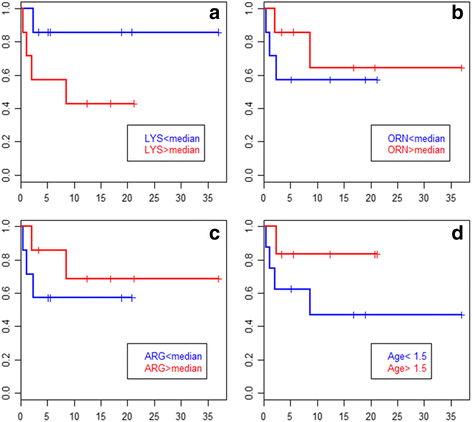Update on Lysinuric Protein Intolerance, a Multi-faceted Disease Retrospective cohort analysis from birth to adulthood
- PMID: 28057010
- PMCID: PMC5217205
- DOI: 10.1186/s13023-016-0550-8
Update on Lysinuric Protein Intolerance, a Multi-faceted Disease Retrospective cohort analysis from birth to adulthood
Abstract
Background: Lysinuric protein intolerance (LPI) is a rare metabolic disease resulting from recessive-inherited mutations in the SLC7A7 gene encoding the cationic amino-acids transporter subunit y+LAT1. The disease is characterised by protein-rich food intolerance with secondary urea cycle disorder, but symptoms are heterogeneous ranging from infiltrative lung disease, kidney failure to auto-immune complications. This retrospective study of all cases treated at Necker Hospital (Paris, France) since 1977 describes LPI in both children and adults in order to improve therapeutic management.
Results: Sixteen patients diagnosed with LPI (12 males, 4 females, from 9 families) were followed for a mean of 11.4 years (min-max: 0.4-37.0 years). Presenting signs were failure to thrive (n = 9), gastrointestinal disorders (n = 2), cytopenia (n = 6), hyperammonemia (n = 10) with acute encephalopathy (n = 4) or developmental disability (n = 3), and proteinuria (n = 1). During follow-up, 5 patients presented with acute hyperammonemia, and 8 presented with developmental disability. Kidney disease was observed in all patients: tubulopathy (11/11), proteinuria (4/16) and kidney failure (7/16), which was more common in older patients (mean age of onset 17.7 years, standard deviation 5.33 years), with heterogeneous patterns including a lupus nephritis. We noticed a case of myocardial infarction in a 34-year-old adult. Failure to thrive and signs of haemophagocytic-lymphohistiocytosis were almost constant. Recurrent acute pancreatitis occurred in 2 patients. Ten patients developed an early lung disease. Six died at the mean age of 4 years from pulmonary alveolar proteinosis. This pulmonary involvement was significantly associated with death. Age-adjusted plasma lysine concentrations at diagnosis showed a trend toward increased values in patients with a severe disease course and premature death (Wilcoxon p = 0.08; logrank, p = 0.17). Age at diagnosis was a borderline predictor of overall survival (logrank, p = 0.16).
Conclusions: As expected, early pulmonary involvement with alveolar proteinosis is frequent and severe, being associated with an increased risk of death. Kidney disease frequently occurs in older patients. Cardiovascular and pancreatic involvement has expanded the scope of complications. A borderline association between increased levels of plasma lysine and poorer outome is suggested. Greater efforts at prevention are warranted to optimise the long-term management in these patients.
Keywords: Amyloidosis; Hemophagocytic lymphohistiocytosis; Hyperammonemia; Inborn error of metabolism; Lupus; Lysine; Lysinuric protein intolerance; Myocardial infarction; Pulmonary alveolar proteinosis; Urea Cycle disorder.
Figures



References
-
- Schwartz GJ, Haycock GB, Edelmann CM, Spitzer A. A simple estimate of glomerular filtration rate in children derived from body length and plasma creatinine. Pediatrics. 1976;58:259–63. - PubMed
MeSH terms
Substances
Supplementary concepts
LinkOut - more resources
Full Text Sources
Other Literature Sources
Medical
Research Materials

